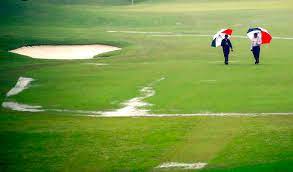The game of golf has always been closely tied to nature and the outdoors. As such, it is no surprise that weather conditions can have a significant impact on golf performance. From the temperature and wind speed to the amount of precipitation, there are a variety of weather factors that can impact a golfer’s game. In this article, we will explore the impact of weather conditions on golf performance and provide some tips on how to adjust your game to different weather conditions.
Temperature
Temperature is one of the most significant weather factors that can impact golf performance. Extremely high or low temperatures can make it challenging for golfers to play at their best. In extremely high temperatures, golfers can become fatigued more easily, impacting their ability to focus and maintain their swing mechanics. Similarly, in extremely cold temperatures, golfers may struggle to stay warm, impacting their ability to make consistent swings.

In moderate temperatures, golfers are better able to maintain their focus and stamina, leading to better overall performance. However, it is important to note that the ideal temperature for golf performance may vary depending on the individual golfer. Some golfers may prefer slightly cooler temperatures, while others may prefer slightly warmer temperatures. As such, it is essential to experiment with different temperatures and determine which temperature range works best for you.
Wind
Wind is another weather factor that can have a significant impact on golf performance. Strong winds can make it challenging for golfers to control their shots, leading to wayward shots that miss their intended target. In addition, wind can impact the distance a ball travels, making it more difficult for golfers to gauge how far their shots will travel.
To adjust your game to windy conditions, it is important to focus on accuracy rather than distance. Use shorter clubs and make more controlled swings to keep the ball low and minimize the impact of the wind. In addition, it can be helpful to play shots that work with the wind rather than against it. For example, if the wind is blowing left to right, aim slightly to the left to allow the wind to push the ball back towards the target.
Rain
Rain is another weather factor that can have a significant impact on golf performance. In wet conditions, golfers may struggle to maintain their grip on the club, impacting their ability to make consistent swings. In addition, wet conditions can impact the roll of the ball, leading to shots that do not travel as far as intended.
To adjust your game to wet conditions, it is important to focus on accuracy and consistency. Use shorter clubs and make more controlled swings to minimize the impact of the wet conditions on your grip. In addition, it can be helpful to adjust your stance to provide a more stable base and minimize the risk of slipping. Finally, it may be helpful to adjust your shot selection to avoid shots that require the ball to roll a long distance.
Snow
Snow is another weather condition that can impact golf performance, although it is less common than the other weather conditions discussed in this article. In snowy conditions, it can be challenging to maintain a consistent stance and make controlled swings. In addition, the ball may not travel as far due to the resistance created by the snow.
To adjust your game to snowy conditions, it is important to focus on maintaining your balance and making controlled swings. Use shorter clubs and take more time to set up your shot to ensure a stable stance. In addition, it may be helpful to adjust your shot selection to avoid shots that require the ball to roll a long distance. Finally, it may be helpful to play with cultured golf balls to improve visibility in the snow.
Weather conditions can have a significant impact on golf performance. From temperature and wind to precipitation and snow, there are a variety of weather factors that can impact a golfer’s game. To adjust your game to different weather conditions,
it is important to focus on accuracy, consistency, and maintaining a stable stance. Use shorter clubs, make controlled swings, and adjust your shot selection to work with the weather conditions rather than against them. By doing so, you can improve your overall golf performance and maximize your chances of success on the course.
It is also important to note that weather conditions can change quickly on the golf course. As such, it is important to be prepared for different weather conditions and have the necessary equipment and clothing to adjust your game as needed. This includes having waterproof clothing for wet conditions, warm clothing for cold conditions, and sunglasses or a hat for sunny conditions.
In addition, it is important to stay hydrated and take breaks as needed to avoid fatigue and maintain focus. This is especially important in extreme weather conditions, such as high temperatures, where the risk of dehydration and heat stroke is higher.

Finally, it is important to stay safe on the golf course in all weather conditions. In thunderstorm conditions, for example, it is important to seek shelter and avoid playing until the storm has passed. Similarly, in extremely hot or cold conditions, it is important to take steps to avoid heat stroke or hypothermia.
weather conditions can have a significant impact on golf performance.
From temperature and wind to precipitation and snow, different weather factors require golfers to adjust their game to maintain accuracy, consistency, and stability. By doing so, golfers can improve their overall performance and maximize their chances of success on the course. It is also important to stay safe on the course in all weather conditions and be prepared with the necessary equipment and clothing to adjust to changing weather conditions.
Overall, weather conditions are a natural aspect of playing golf that cannot be controlled.
However, golfers can adapt and adjust their game to the different weather conditions they encounter on the course. By doing so, golfers can improve their performance, enjoy their time on the course, and stay safe and healthy while playing.
Furthermore, the impact of weather conditions on golf performance is not just limited to individual play. Weather conditions can also have an impact on golf tournaments and competitions, where golfers must perform at their best under different weather conditions. In major golf tournaments, such as the British Open, weather conditions are often unpredictable and can play a significant role in determining the winner.
For example, at the 2002 British Open, the weather was cold, wet, and windy throughout the tournament. Golfers had to adjust their game to the challenging weather conditions, and the winner, Ernie Els, finished the tournament at 6 under par, a score that was much higher than the typical winning score at the British Open. The challenging weather conditions made it difficult for golfers to make birdies and eagles, leading to a more competitive and exciting tournament.
In conclusion,
Weather conditions have a significant impact on golf performance, from individual play to major tournaments. Golfers must adapt and adjust their game to different weather conditions to maintain accuracy, consistency, and stability. By doing so, golfers can improve their overall performance and maximize their chances of success on the course. As a natural aspect of playing golf, weather conditions add an element of unpredictability and excitement to the game, making it a unique and challenging sport to play.




